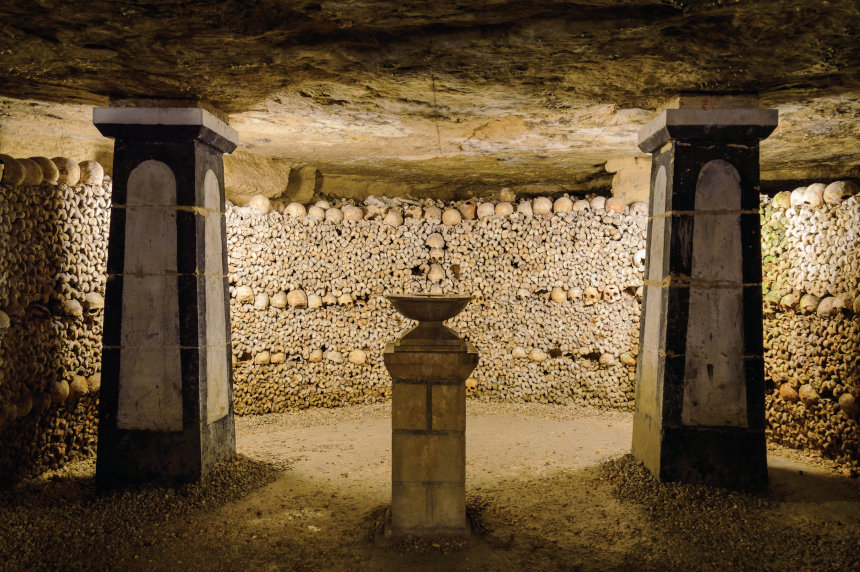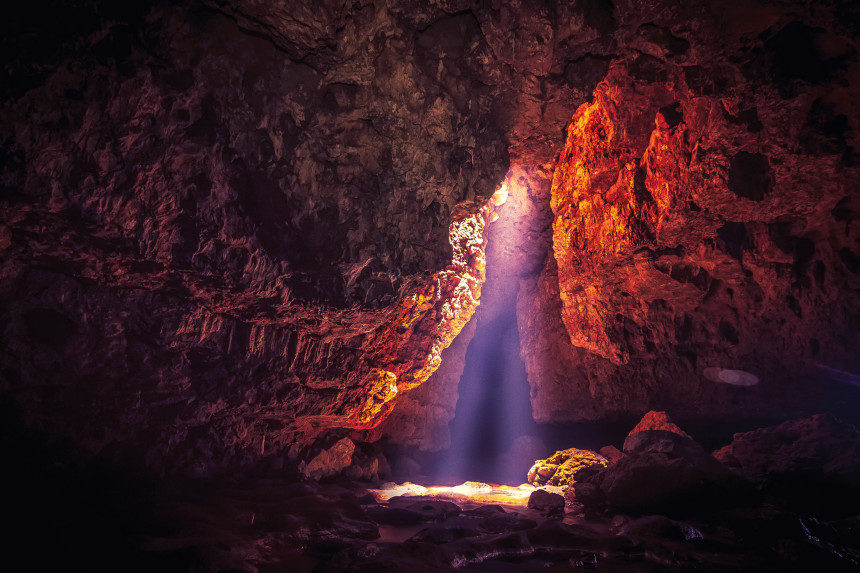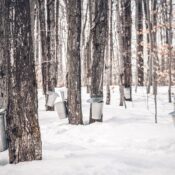Find hints of it everywhere you go, evidence of an unseen world. Step out your front door and feel beneath your feet the thrum of subway tunnels and electric cables, mossy aqueducts and pneumatic tubes, all interweaving and overlapping like threads in a wild loom. At the end of a quiet street, find vapor streaming out of a ventilation grate, which may rise from a hidden tunnel where outcasts dwell in jerry-rigged shanties, or from a clandestine bunker with dense concrete walls, where the elite will flee to escape the end of days. On a long stroll through quiet pastureland, run your hands over a grassy mound that may conceal the tomb of an ancient tribal queen, or perhaps the buried fossil of a prehistoric beast with a long snaking spine. Hike down a shaded forest trail, where you cup your ear to the earth and hear the scuttle of ants excavating a buried metropolis, full of tiny whorled passageways. Trekking up in the foothills, you smell an earthy aroma emanating from a crack in the stone, the sign of a giant hidden cave, where the stony walls are graced with ancient charcoal paintings. And everywhere you go, beneath every step, you feel a quiver coming up from deep, deep below, where titanic bodies of stone shift and grind against one another, causing the earth to tremble and shudder.
If the surface of the earth were transparent, we’d spend days on our bellies, peering down into this marvelous layered terrain. But for us surface-dwellers, going about our lives in the sunlit world, the underground has always been invisible. Our word for the underworld, Hell, is rooted in the Proto-Indo-European kel–, for “conceal”; in ancient Greek, Hades translates to “the unseen one.” Today, we have newfangled devices — ground-penetrating radar and magnetometers — to help us visualize the underground, but even our sharpest images come out distant and foggy, leaving us like Dante, squinting into the depths: “so dark and deep and nebulous it was, / try as I might to force my sight below / I could not see the shape of anything.” In its obscurity, the underground is our planet’s most abstract landscape, always more metaphor than space. When we describe something as “underground” — an illicit economy, secret rave, undiscovered artist — we are typically describing not a place but a feeling: forbidden, unspoken, otherwise beyond the known and ordinary.
Our word for the underworld, Hell, is rooted in the Proto-Indo-European kel-, for “conceal.”
Geologists believe that more than half of the world’s caves are undiscovered, hermetic chambers down in the crust that will never be seen. The journey from where we now sit to the center of the Earth is equal to a trip from New York to Paris, and yet the planet’s core is a black box, a place whose existence we accept on faith. The deepest we’ve burrowed underground is the Kola borehole in the Russian Arctic, which reaches 7.6 miles deep — less than one half of one percent of the way to the center of the Earth. The underground is our ghost landscape, unfolding everywhere beneath our feet, always out of view.
But as a boy, I knew that the underworld was not always invisible — to certain people, it could be revealed. In my parents’ old edition of D’Aulaires’ Book of Greek Myths, I read of Odysseus, Hercules, Orpheus, and other heroes who ventured down through craggy portals in the earth, crossed the river Styx on Charon’s ferry, gave the slip to three-headed Cerberus, and entered Hades, the land of shades. The one who most captivated me was Hermes, the messenger god, he of the winged helmet and sandals. Hermes was god of boundaries and thresholds, and the guide of the souls of the dead into Hades. (He bore the marvelous title of psychopomp, which means “soul conductor.”) While other gods and mortals obeyed the cosmic boundaries, he swooped openly between light and dark, above and below. Hermes — who would become the patron saint of my own underground excursions — was the one true subterranean explorer, who cut through darkness with clarity and grace, who saw the underworld and knew how to retrieve its buried wisdom.
The summer I turned 16, when my world felt as small and known as the tip of my finger, I discovered an abandoned train tunnel running beneath my neighborhood in Providence, Rhode Island. I’d heard about it first from a science teacher at school: a small, whiskery man named Otter, who knew every secret groove in every landscape in New England. The tunnel had once served a small cargo line, he’d told me, but that was years ago. Now it was a ruin: full of mud and garbage and stale air and who knew what else.
One afternoon, I found the entrance, which was concealed under a thicket of bushes behind a dentist’s office. It was wreathed in vines and had the date of its construction — 1908 — engraved in the concrete above its mouth. The city had sealed the entrance with a metal gate, but someone had sliced open a small passageway: Along with a few friends, I climbed underground, our flashlight beams crisscrossing in the dark. The mud sucked at our shoes and the air was boggy. On the ceiling were clusters of pearly nipplelike stalactites that dripped water down on our heads. Halfway through, we dared one another to switch off our lights. As the tunnel fell to perfect darkness, my friends whooped, testing the echo, but I held my breath and stood dead still, as though, if I moved, I might float right off the ground. That night at home, I pulled up an old map of Providence. I started with my finger where we’d entered the tunnel and moved to where it opened at the other end. I blinked: the tunnel passed almost directly beneath my house.
That summer, on days when no one else was around, I’d put on boots and go walking in the tunnel. I couldn’t have explained what drew me down, and I certainly never went with any particular mission. Underground, I’d look at the graffiti or kick around old bottles of malt liquor. Sometimes I’d turn off my light, just to see how long I could last in the dark before my nerves started to bristle.
At the end of that summer, following a heavy rainstorm, I had just climbed beyond the threshold of the tunnel when I heard an unexpected rumble coming from the darkness ahead. Alarmed, I started to turn back, but decided to keep walking, even as the sound grew. Deep in the tunnel, I found the source: a crack in the ceiling — a burst pipe, maybe, or a leak — from which water was pouring down in cascades. Directly beneath the falling water, I saw an overturned plastic beach pail. Then a paint bucket. Then, all at once, an enormous assembly of overturned containers — oil drums, beer cans, Tupperware, gas canisters, coffee tins — all in a giant cluster, arranged under mysterious circumstances by a person I’d never meet. The water drummed down on the vessels, sending up an echoing song, as I stood in the dark, nailed to the floor.
When we describe something as “underground” … we are typically describing not a place but a feeling.
Years passed, and I forgot about those underground walks. I left Providence, went to college, moved on. But my old connection to the tunnel never quite disappeared. Just as a seed silently takes root and ripens and matures down in the hidden earth before sprouting on the surface, my memories of the tunnel quietly germinated for years at the bottom of my mind.
I came to love the underground for its silence and for its echoes. I loved that even the briefest trip into a tunnel or a cave felt like an escape into a parallel reality, the way characters in childhood books vanish through portals into secret worlds. I loved that the underground offered romping Tom Sawyer-ish adventure, just as it opened confrontation with humankind’s most eternal and elemental fears. I loved telling stories about the underground — about relics discovered beneath city streets, or rituals conducted in the depths of caves — and the wonder they engendered in the eyes of my friends. Most of all, I was captivated by the dreamers, visionaries, and eccentrics that the underground attracted: people who’d heard a kind of subterranean siren song and given themselves to exploring, making art, or praying in the underground world.
Over the years, I convinced a research foundation, then various magazines, then a book publisher to give me funding to investigate these things, and I spent that money, and then some, exploring subterranean spaces in different parts of the world. For more than a decade, I climbed down into stony catacombs and derelict subway stations, sacred caves and nuclear bunkers. It began as a quest to understand my own preoccupation; but with each descent, as I became attuned to the deep resonances of the subterranean landscape, a more universal story emerged. I saw that we — all of us, the human species — have always felt a quiet pull from the underground, that we are connected to this realm as we are to our own shadow. From when our ancestors first told stories about the landscapes they inhabited, caves and other spaces beneath our feet have frightened and enchanted us, forged our nightmares and fantasies. Underground worlds, I discovered, run through our history like a secret thread: In ways subtle and profound, they have guided how we think about ourselves and given shape to our humanity.
We have lived among caves and underground hollows for as long as humans have existed, and for just as long, these spaces have evoked in us visceral and perplexing emotions. Evolutionary psychologists have suggested that even our most archaic ancestral relationships to landscapes never quite fade, that they become wired in our nervous system, manifest in unconscious instincts that continue to govern our behavior today.
We are aliens underground. Natural selection has designed us — in every way imaginable, from our metabolic needs, to the lattice-like anatomy of our eyes, to the deep structures of our brain — to stay on the surface, to not go underground. The “dark zone” of a cave — scientists’ name for the parts of a cave beyond the “twilight zone,” which is within the reach of diffuse light — is nature’s haunted house, repository of our deepest-rooted fears. It is home to snakes that twitch down from cave ceilings, spiders the size of Chihuahuas, scorpions with barbed tails — creatures we are evolutionarily hard-wired to fear, because they so often killed our ancestors. Up until about 15,000 years ago — which is to say, for all but the last eyeblink of our species’ existence — every time we came upon a cave mouth, we braced ourselves for a man-eating monster to lunge out of the darkness. Even today, when we peer underground, we feel the flickering dread of predators crouching in the dark.
The feeling of enclosure, too, leaves us unhinged. To be trapped in an underground chamber, our limbs restricted, cut off from light, with dwindling oxygen, may be the emperor of all nightmares. Edgar Allan Poe, the poet laureate of claustrophobia, wrote of subterranean enclosure: “No event is so terribly well adapted to inspire the supremeness of bodily and of mental distress. … The unendurable oppression of the lungs — the stifling fumes from the damp earth — the clinging to the death garments — the rigid embrace of the narrow house — the blackness of the absolute Night — the silence like a sea that overwhelms … ” Down in any underground hollow, we feel, if not a full tempest of panic, a reflexive tingle of not-quite-rightness, as we imagine ceilings and walls closing in on us.
Ultimately, it’s death we fear most: All of our aversions to the dark zone coil together in the dread of our own mortality. Our species has been burying our dead in the dark zones of caves since at least 100,000 years ago. Each time we cross a cave threshold, we feel a reflexive premonition of our eventual death — which is to say, we brush up against the one thing natural selection has designed us to avoid.

And yet, when we crouch at the edge of the underground, we do descend. Virtually every accessible cave on the planet contains the footprints of our ancestors: people who clambered down through rocky apertures in the earth, lighting their way through the gloom with pine torches or tallow lamps. Archaeologists have belly-crawled through muddy passageways in the caves of France, swum down long subterranean rivers in Belize, and trekked for miles inside the limestone caves of Kentucky: everywhere, they have found the fossilized footprints of ancient people, who made mysterious visits to the dark zone. The dark-zone journey may well be humankind’s oldest continuous cultural practice, with archaeological evidence going back hundreds of thousands of years, before our species even existed. No single tradition, writes the mythologist Evans Lansing-Smith, “brings us all together as human beings more than the descent to the underworld.”
To become conscious of the spaces beneath our feet is to feel the world unfold. Our connection to the underground cracks a door into the most inscrutable chambers of the human imagination. We go down to see what is unseen, unseeable — we go in search of illumination that can be found only in the dark.
Will Hunt’s writing, photography, and audio storytelling have appeared in The Economist, The Paris Review Daily, Discover, and Outside, among other places. Underground is his first book.
From the book Underground: A Human History of the Worlds Beneath Our Feet by Will Hunt, Copyright © 2018 by Will Hunt. Published by Spiegel & Grau, an imprint of Random House, a division of Penguin Random House LLC
This article is featured in the September/October 2020 issue of The Saturday Evening Post. Subscribe to the magazine for more art, inspiring stories, fiction, humor, and features from our archives.
Featured image: Shutterstock
Become a Saturday Evening Post member and enjoy unlimited access. Subscribe now



